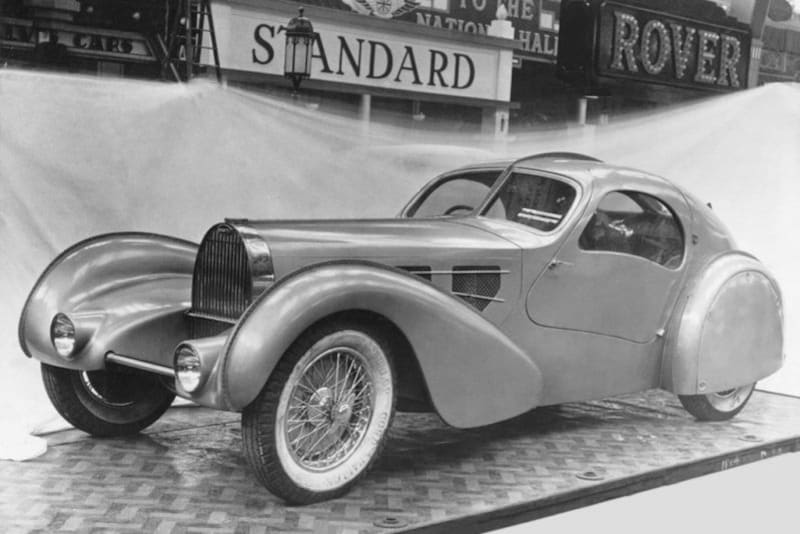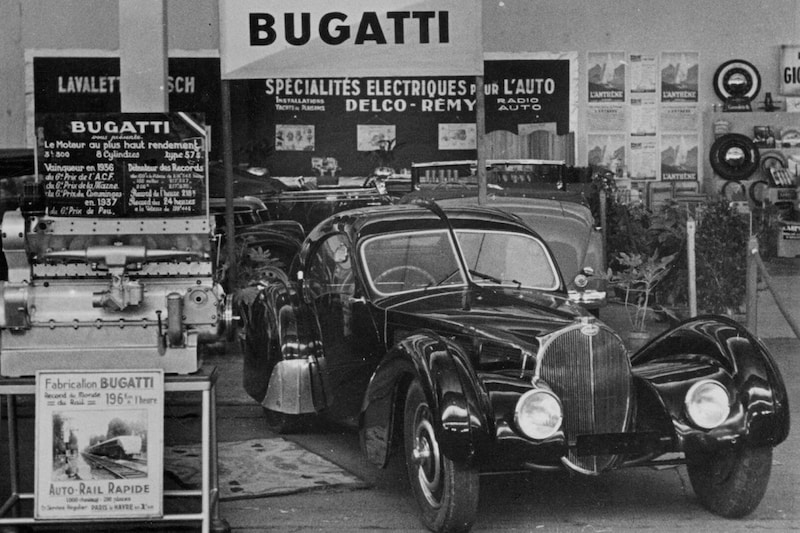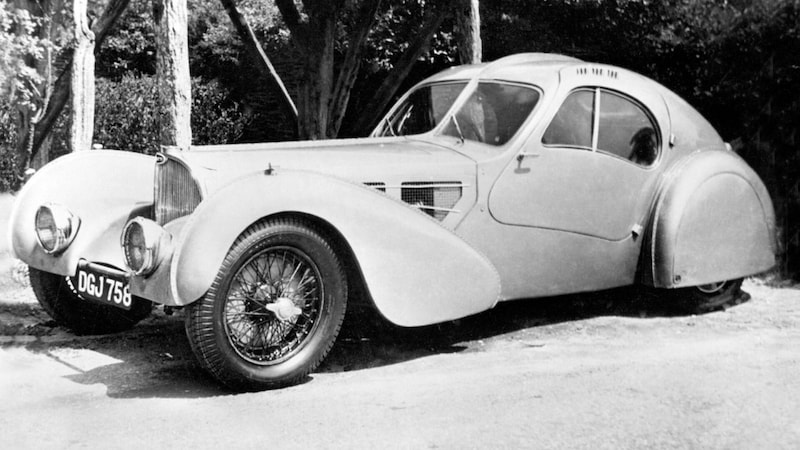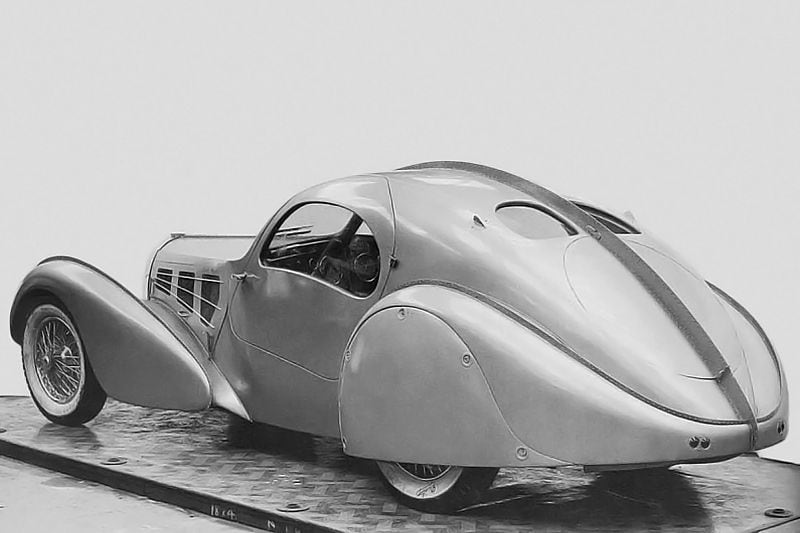Mysteries: sometimes they’re pretty far-fetched, but sometimes they’re also lifelike. The story of the Bugatti Type 57 SC ‘La Voiture Noire’ belongs to the latter category. Since 1938, one of the four 57 SCs that Bugatti built has been missing from that car, namely every trace…
The Bugatti Type 57 was the brainchild of Jean Bugatti, the son of founder Ettore Bugatti. Jean wanted to create a different kind of model range for Bugatti with the 57. He came up with one basic model that could be ordered in different variants. You had the original Type 57 and the lowered Type 57 S, where the ‘S’ stands for ‘Surbaissé’ (lowered). Both variants of the Type 57 were available with a supercharger, after which the addition ‘C’ (Compresseur) appeared after the model name. As was customary at the time, coachbuilders were often responsible for the diverse range of body styles, including the Ventoux and Galibier (two- and four-door sedan), Stelvio (convertible) and Atalante (Coupé). In the end, 710 different types of the Type 57 saw the light of day in this way.
All remaining Bugatti’s Type 57 are now very expensive, but one model takes the cake: the Atlantic Coupé. The Atlantic descends from the 1936 Aérolithe concept car. The Aérolithe was a special thing to see. For example, the headlights were almost integrated into the fenders and the car had a split front and rear windows, which were connected by a tail fin that ran across the roof. Furthermore, the rounded shapes are characteristic of the Aerolithe, the roof that extends all the way down to the rear and the covered rear wheel arches further enhance the aerodynamic appearance. The Aerolithe was riveted together. That was not for show, because the Aérolithe was built from Elektron composite, a material consisting of 90 percent magnesium and 10 percent aluminum. This material was known to catch fire when it got hot. So welding was not an option.

The Bugatti Aerolith.
Those rivets eventually returned in the production version of the Aérolithe: the Atlantic. On the Atlantic they were for show, because Bugatti chose to use regular aluminum for the Atlantic instead of Elektron. Incidentally, the Atlantic owes its name to Jean Mermoz, a pilot and friend of Jean Bugatti who died while flying over the Atlantic Ocean. In appearance, the Atlantic is in any case very similar to the Aérolithe. In addition to the rivets in the fin on the roof, the long hood, the continuous rear and the six exhausts are characteristic styling features of the Atlantic. Incidentally, the Atlantic may seem very long in the photos, but with a length of 3.7 meters it is not exactly that. For comparison: a Volkswagen Polo now measures 4.07 meters in length.
All unique
Bugatti eventually built only four copies of the 57S Atlantic. Those four copies had chassis numbers 57374, 57453, 57473 and 57591. No Atlantic is the same. The most prominent difference is that two Atlantics (57374 and 57591) had headlamps in the front fenders, while the other two were more traditionally mounted on the fenders. The last Atlantic, with chassis number 57591, is currently one of the most famous. It resides in the extensive car collection of the well-known fashion designer Ralph Lauren.

The four Atlantics in a row.
But the most special Atlantic has to be the one with chassis number 57453. That was the car that Bugatti wanted to use as a car for the brochures, at shows and during tests. Jean Bugatti reportedly drove the car himself and allowed only a select group of friends to drive it around. Jean’s car was also the only Atlantic that received a factory supercharger. ‘La Voiture Noire’, as the black 57SC was also called, was therefore the only one to bear the two letters SC from the start. With a supercharger, the 3.3-liter in-line eight was good for 200 hp. The chassis numbers 57374 and 57591 were later fitted with the supercharger, so that they could carry the letter ‘C’. Chassis 57473 is the only one that has to do without extra ventilation.
Never showed up again
None of the Type 57 Atlantics are completely original anymore. All three surviving cars have a unique story, with the last Ralph Lauren built being the least battered in its past. One Atlantic has completely disappeared from the radar: the aforementioned La Voiture Noire by Jean Bugatti himself. Jean Bugatti, driver William Grover-Williams and his wife Yvonne reportedly shared the car in the winter of 1936, the year the car was built. In 1937 Jean drove it himself for a while before giving the car as a gift to driver Robert Benoist, who won the 1937 24 Hours of Le Mans for Bugatti. Benoist and Grover-Williams, who were close friends, shared the car afterward. When they fled to England in the spring of 1940, the car was returned to the factory, where after the outbreak of World War II the car was said to have been put on a train by Father Ettore to keep it out of the clutches of the Germans. Jean Bugatti had unfortunately lost his life in a car accident in 1939.

Bugatti Type 57 SC ‘La Voiture Noire’.
To this day, it is not known where the car went after that. The above rumors about who drove the car and when have never been officially confirmed, as the history of the ‘La Voiture Noire’ is poorly documented. This is mainly because the car was never sold or registered, it has always been owned by Bugatti. The manufacturer itself indicates that it lost track of the second Atlantic after 1938. Everything that happened to the car after that remains a mystery. That obscurity fuels theories that the car is currently still hidden somewhere on Earth. Other theories about the car include that Ettore Bugatti himself wanted to keep it hidden or that the car was put on a ship to America.
Should the ‘La Voiture Noire’ ever appear, it will probably immediately be the most valuable car in the world. The special story would partly ensure that the value of the Bugatti towers well above €100 million. It may turn up in a similar way to the Bugatti Type 22 Brescia, which was once found in a lake after being submerged for 75 years. Until then, treasure hunters can go on an adventure to solve the mysterious disappearance of the Type 57 SC. Bugatti itself paid tribute to the legendary car earlier this year. Will anyone ever find the original?
– Thanks for information from Autoweek.nl




